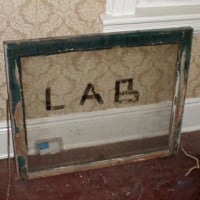Welcome to the FlexRadio Community! Please review the new Community Rules and other important new Community information on the Message Board.
Need the latest SmartSDR or 4O3A Genius Product Software?
SmartSDR v4.1.3 | SmartSDR v4.1.3 Release Notes
SmartSDR v3.10.15 | SmartSDR v3.10.15 Release Notes
The latest 4O3A Genius Product Software and Firmware
SmartSDR v4.1.3 | SmartSDR v4.1.3 Release Notes
SmartSDR v3.10.15 | SmartSDR v3.10.15 Release Notes
The latest 4O3A Genius Product Software and Firmware
If you are having a problem, please refer to the product documentation or check the Help Center for known solutions.
Need technical support from FlexRadio? It's as simple as Creating a HelpDesk ticket.
Need technical support from FlexRadio? It's as simple as Creating a HelpDesk ticket.
Disconnect RX A input on transmit?
Grant Kesselring
Member ✭✭
I think I know the answer to this question, but I'm curious if I'm on the right track.
I have the 6600M and I sometimes use a separate transmit and receive antenna. The transmit antenna is fed from the "ANT1" port, and the receive loop is connected to "RX A" port. My questions is: Is there any SSDR option to disconnect RX A RF input on transmit?
Although I've never noticed any problems, I am concerned about the return energy that comes back into the RF A input while transmitting. The transmit antenna is an Inverted-L, and the RX antenna is an Apex array loop. They are separated by about 75ft.
Back when I was using a Flex 5000 w/2nd RX unit with PowerSDR, I remember there being a software option that would disconnect the RX2 port when transmitting so didn't know if there was something similar in SSDR that I'm missing.
Is there something else I should be doing to protect the Flex front-end while TX'ing at the same time receiving with RX A?
I've heard about this...
https://www.arraysolutions.com/as-rxfep
I'd be interested to hear what others do, or their experiences with different products.
I have the 6600M and I sometimes use a separate transmit and receive antenna. The transmit antenna is fed from the "ANT1" port, and the receive loop is connected to "RX A" port. My questions is: Is there any SSDR option to disconnect RX A RF input on transmit?
Although I've never noticed any problems, I am concerned about the return energy that comes back into the RF A input while transmitting. The transmit antenna is an Inverted-L, and the RX antenna is an Apex array loop. They are separated by about 75ft.
Back when I was using a Flex 5000 w/2nd RX unit with PowerSDR, I remember there being a software option that would disconnect the RX2 port when transmitting so didn't know if there was something similar in SSDR that I'm missing.
Is there something else I should be doing to protect the Flex front-end while TX'ing at the same time receiving with RX A?
I've heard about this...
https://www.arraysolutions.com/as-rxfep
I'd be interested to hear what others do, or their experiences with different products.
0
Answers
-
I use a (EA4TX AS2x2) relay keyed by PTT to disconnect the RX antenna during TX. I also use the Array Solutions RXFEP Front End Protector as a failsafe. Additionally, the Flex 6xxx series has protection built in to protect the RX front end from overload. Better to be safe than sorry!0
-
Grant,,see if this help with your concerns.
Official Response From Steve
In general there is 40-50dB isolation between ANT1 and ANT2 and >90dB between ANT1/2 and RX A, RX B or XVTR. This is, then, added to the antenna isolation you have at your site. If you have concerns about this, one of the good ways to test is to set your radio for 1W and then try combinations and measure what you see in the panadapter. The radio is calibrated at 1W so you should be able to calculate isolation and extrapolate without any concerns. There is also a worksheet to help you determine if you need more isolation here: FLEX-6000 FDX Power Calculation Worksheet
0 -
That Spreadsheet seems to be gone? Just gets; Oops, This Page Could Not Be Found!
Anyone? A new valid link?
0 -
-
Also, here are tables of modeled coupling power by type of antenna, frequency, and spacing along with some rules of thumb. I found the info handy when planning my Rx antenna locations:
https://www.w8ji.com/antenna_coupling.htm
I use the Array Solution protectors too. DX Engineering has similar devices. From what I hear both are excellent.
Howard
0 -
Tnx, both John and Howard. Need to do some studying while I have started setting up and trying SO2R a bit more seriously.
0 -
I am using the DX Engineering version of that Array Solutions RX front end protector. have not had a single issue.
0 -
Hi
You should be fine. The front end of the RXA is well protected and it takes over a -10dbm signal at that point to cause an alarm (off the top of my head--I forget the exact number). You do need to take some care that your beverage is not right in the middle of a 1500 watt signal. I helps to be more thatn 1 wavelength away.
SmartSDR will alarm if you are getting high RF signals. Greater than a certain level, the input will clap down.
Mike
2
Leave a Comment
Categories
- All Categories
- 379 Community Topics
- 2.1K New Ideas
- 631 The Flea Market
- 8.2K Software
- 120 SmartSDR+
- 6.4K SmartSDR for Windows
- 183 SmartSDR for Maestro and M models
- 430 SmartSDR for Mac
- 271 SmartSDR for iOS
- 259 SmartSDR CAT
- 193 DAX
- 382 SmartSDR API
- 9.3K Radios and Accessories
- 38 Aurora
- 261 FLEX-8000 Signature Series
- 7.2K FLEX-6000 Signature Series
- 947 Maestro
- 56 FlexControl
- 866 FLEX Series (Legacy) Radios
- 924 Genius Products
- 463 Power Genius XL Amplifier
- 336 Tuner Genius XL
- 125 Antenna Genius
- 297 Shack Infrastructure
- 209 Networking
- 460 Remote Operation (SmartLink)
- 144 Contesting
- 787 Peripherals & Station Integration
- 139 Amateur Radio Interests
- 1K Third-Party Software




